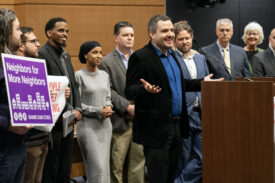Courtesy of Sightline Daily’s news service, I caught this gem from The New York Times. Over the weekend, Los Angeles shut down a ten-mile stretch one of the busiest freeways in the nation, I-405. For weeks, pundits predicted “Carmaggedon!!!” would ensue—gridlock traffic that would bring the city to its knees.
But, the hype around the looming disaster proved to be exaggerated:
“[P]eople in Los Angeles woke up Saturday to something many had rarely, if ever, seen: empty streets. An afternoon aerial tour over Los Angeles in a Fire Department helicopter — lifting off from the roof of a downtown city skyscraper, over the Sepuldeva Pass and into the San Fernando Valley, and looping back by the Los Angeles Airport — left city officials gape-jawed at empty highways and streets in places where summer Saturdays normally mean hot and vexing crawls.”
If you’re from Seattle, this will surely remind you a similar incident we experienced back in 2007—“The Clog”—when the city lost two lanes of I-5 through downtown for 19 days. Like LA, there were dire predictions of nightmare traffic. But in the end, exactly the opposite happened:
“Peak commuting-time traffic wasn’t just lighter than expected, it was lighter than at any time in recent memory.
It was, in the words of one post on The [so-called] Clog, ‘Maybe the best commute ever.'”
Don’t get me wrong—if you randomly start shutting down major roads, there would probably be some problems. But in both of these cases, people had ample warning (LA even recruited major celebrities like Lady Gaga to Tweet about it in advance) and made changes that kept a catastrophe at bay. What it suggests for the Northwest—well, Clark’s words from four years ago say it best:
“[C]losing I-5 for a few slow summer weeks [isn’t] exactly the same thing as closing the Viaduct for good. But if the traffic engineers’ dire predictions for gridlock on I-5 didn’t come true this time, isn’t it possible that commuters will be every bit as clever and flexible—and the transportation network every bit as resilient—once the Viaduct comes down?”
Certainly, a large part of LA’s disaster-that-wasn’t was due to the fact that it was a temporary closure, and people simply pushed back trips to the next weekend, cancelled unnecessary ones, or found alternatives. But it reveals encouraging flexibility drivers have when it comes to where we go and when—especially if we have good information and choices.








